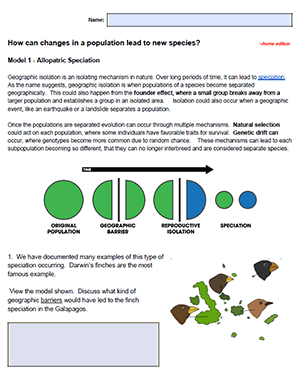
This activity was designed for students during the COVID-19 pandemic and is intended to be completed individually at home. The lesson explores the two models of speciation: allopatric and sympatric. You can also assign a simple print version that explores speciation modes.
Students first read about allopatric speciation and apply it to the finches on the Galapagos islands. Each finch species became isolated on its own island, which resulted in each island having a unique species.
Students then explore “Reproductive Barriers” at Learn.Genetics. This is a semi-interactive slide show that looks at several examples of reproductive barriers, such as behaviors and geographic.
Reproductive isolating mechanisms prevent different species from breeding and can lead to the evolution of a new species. A chart in the worksheet is completed by clicking through the slides and summarizing the examples.
In the last section of the lesson, students explore sympatric speciation, by reading about the apple maggot fly. The final synthesis question asks to explore how reproductive isolation differs for each mode. Presumably, students will realize that allopatric relies mainly on geographic isolation, but sympatric requires other mechanisms, such as timing, behaviors, or niche choice.
The google doc is set up with fields for students to input their information and the downloadable pdf document also has form fields. The idea is that students can do this online and submit via Google Classroom.
I also pair this with an Amoeba Sisters video on speciation that I share on Edpuzzle with embedded questions. I do not have an answer key for this worksheet, mainly because there is a lot of flexibility with how students can answer the questions and complete the chart. Answers will vary.
HS-LS4-4 – Construct an explanation based on evidence for how natural selection leads to adaptation of populations.
HS-LS4-5 Evaluate the evidence supporting claims that changes in environmental conditions may result in: (1) increases in the number of individuals of some species, (2) the emergence of new species over time, and (3) the extinction of other species.

